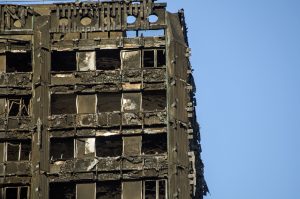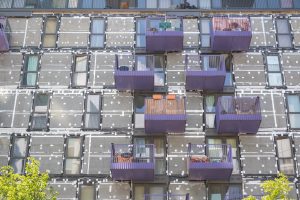The UK government has called for a meeting with Kingspan, the manufacturer of combustible insulation used on Grenfell Tower, to discuss cladding compensation
In 2017, 72 people died due to a fire that broke out in Grenfell Tower due to its flammable cladding and insulation. The events at Grenfell Tower have led to an ongoing investigation into who was responsible for the tower’s failure and subsequent fatalities. Since then, there have been many calls for action against those responsible, including manufacturers like Kingspan whose products were found to have played a role in the disaster. Michael Gove, Secretary of State for Levelling Up, Housing and Communities, has called for meetings between himself and representatives from these companies as part of his plan to provide cladding compensation for victims of the incident.
In a tweet, Gove wrote:
I have written to cladding firm Kingspan following their claim that they are willing to take financial responsibility for their role in the Grenfell tragedy & building safety crisis. I hope they will urgently meet with my officials to discuss this following their record profits
pic.twitter.com/Gptl3gw1wu
— Michael Gove (@michaelgove) March 28, 2023
The long-term implications of this crisis are yet to be fully understood and have already caused a great deal of distress for residents living in affected properties. In addition to significant safety risks associated with the use of such materials, building regulations have also been called into question due to their lack of enforcement.
The government’s response to this issue has so far focused primarily on establishing an independent review panel tasked with assessing how combustible cladding was allowed to become widespread in UK buildings. As part of its remit, the panel will investigate regulatory compliance and enforcement by relevant authorities throughout the years since legislation outlining fire safety measures came into force in 2006.
Furthermore, there have been calls from many quarters for those responsible for implementing faulty or non-compliant fire protection systems to face criminal sanctions if found guilty. Despite this, many individuals and organisations involved in introducing these products onto the market remain unaccountable for any negligence shown at the time.
This latest development follows increasing pressure from both industry leaders and members of Parliament alike for greater action from local councils and private landlords who were slow to act when concerns about flammable cladding began surfacing several years ago. With Gove recently signalling his intention to convene a meeting between representatives from Kingspan, it seems efforts are finally being made towards finding meaningful solutions to this complex problem.
Recent developments on cladding compensation plans
The government has proposed a fund of £3bn to cover costly fees due to the installation of dangerous combustible cladding. However, this is unlikely to be enough as it would only cover 30% of total estimated costs. However, any agreement reached between Kingspan and the government may provide additional relief for those affected by the crisis. Furthermore, the Insurance Sector has been urged to play its part in helping people who are facing huge bills for remedial work on their homes caused by unsafe cladding. The Financial Conduct Authority (FCA) has stated that insurers must take responsibility for paying claims if appropriate insurance policies were taken out at the time when construction took place or when refurbishment occurred.
Additionally, an independent review of building regulations will soon be conducted as part of efforts to prevent similar crises from occurring in the future. It is expected that Dame Judith Hackitt’s Review 2.0 will include recommendations towards revising current regulation standards across all types of multi-occupancy residential buildings in England. The terms of reference outlining what the review should address are still being determined along with details regarding how it will be conducted and overseen; however, it is evident that action needs to be taken swiftly in order for public safety concerns surrounding flammable materials used in housing developments to be resolved effectively and efficiently.
Given these latest developments, there is hope amongst victims of this crisis that significant steps are finally being taken towards resolving issues involving compensations payments and improving overall fire safety standards within residential properties in England
How has the cladding crisis impacted homeowners?
The cladding crisis has had a devastating impact on homeowners throughout the UK. Victims of botched construction or inadequate safety standards have been left in financial hardship with no reliable path to compensation. This issue has caused significant debt and anxiety for owners as they struggle to find solutions in an environment that is often unresponsive to their needs.
Banks and lenders have become increasingly unwilling to grant mortgages, remortgages or loan extensions when it comes to properties affected by unsafe cladding materials. Homeowners are thus forced into expensive short-term loans which perpetuate the cycle of financial insecurity. With many people unable to access sufficient funds, some are having difficulty meeting basic living expenses such as rent or bills.
The lack of clear guidance from authorities over what constitutes ‘safe’ building material further compounds this problem for victims of fire risk cladding who strive for clarity in order to make informed decisions about their property investments. Many are being asked to pay thousands of pounds out of their own pockets despite limited evidence that these costs will be reimbursed at any point in the future.
A number of legal cases have emerged with varying levels of success where homeowners seek recompense from those responsible for installing non-compliant materials on buildings across Britain; however, this can be a lengthy process that puts individuals under additional strain while awaiting resolution. It is essential that action is taken swiftly in order to provide relief for those already suffering due to the consequences of the cladding crisis and prevent others from falling victim too.
What is the government’s role in cladding compensation?
As the cladding crisis continues to impact homeowners, the government has stepped in to take an active role in the compensation process. Robert Jenrick, Secretary of State for Levelling Up, Housing and Communities from 2019-2021, met with representatives from Kingspan Insulation to discuss potential solutions for homeowners. Representatives from other leading industry bodies were also invited to attend this meeting and contribute their input.
This is not the first time that the government has made efforts towards finding solutions for those affected by the cladding crisis. In December 2020, they announced a new warranty scheme which would provide insurance cover against future costs associated with unsafe combustible cladding. This scheme was welcomed by many as it provided much-needed assurance that any additional costs required due to faulty building materials would be covered by insurers. It also meant that freeholders and leaseholders could feel more secure about carrying out necessary works without being concerned about financial repercussions further down the line.
In addition to creating new schemes like these, there are also plans in place for a non-industry levy which will generate funds to support owners who cannot access help or funding elsewhere. Although details have yet to be finalised, some estimates suggest this levy could raise up to £1bn over 5 years and significantly reduce the likelihood of people having to pay large sums themselves for repairs when remedial work is needed on their properties due to faults caused by dangerous materials.

Kingspan has had significant involvement in the cladding scandal
The Kingspan Group is a major player in the construction industry, and its involvement in the ongoing cladding scandal has been significant. The company produces insulated walling products, which have allegedly been used on hundreds of buildings around the country that are now known to be highly flammable. As a result, there have been widespread calls for compensation from those affected by the product liability issue.
Kingspan’s role as one of the biggest suppliers of insulation materials meant they were at the heart of this controversy before it even began. In 2019, evidence emerged linking them to buildings across England and Wales where combustible cladding was being used despite regulations stipulating that only non-combustible material should be installed on high-rise structures over 18 meters tall.
Since then, several investigations into building fire safety standards have taken place, all concluding that many more buildings could face similar issues due to inadequate testing regimes or the use of dangerous materials like polyethylene (PE). Unsurprisingly, these reports recommended that companies such as Kingspan need to be held accountable not just for failing to meet safety requirements but also for providing potentially hazardous products without warning customers about potential risks associated with installation.
300,000 buildings are affected by combustible cladding
Recent data suggests that over 300,000 buildings in the UK are affected by combustible cladding. The discussion of what measures should be taken in order to compensate for the current fire-safety issues with cladding has been a top priority since the devastating Grenfell Tower blaze. It is clear that government, councils and housing associations must come together to address this issue and consider further steps to improve safety standards.
To begin, it is essential to review existing building regulations on cladding, particularly those concerning combustible materials used in insulation or external walls of buildings. Furthermore, an assessment of whether the appropriate fire-safety tests have been conducted prior to installation needs to take place. This would provide information as to how well certain products are designed to resist flames and heat spread from fires. Additionally, local authorities must ensure they are regularly inspecting any high-rise residential buildings constructed before 2010 which may contain potentially dangerous materials.
Furthermore, more stringent controls need to be put in place regarding testing procedures for new products intended for use in public areas such as schools, hospitals and offices. Currently, these tests are not mandatory so there is no guarantee that products meet the required standards needed for protection against fire hazards. Similarly, better enforcement of existing requirements by local authorities can help prevent unsafe installations and promote compliance with health and safety legislation.
In light of this situation, it is important that all stakeholders involved take responsibility for ensuring adequate building standards are met when constructing or refurbishing homes or other public spaces where people work and live. Clear guidelines around product selection and installation processes must be established in order to reduce risks associated with potential failures due to inadequate fire-safety testing methods, lack of inspections or poorly executed maintenance activities. Ultimately all parties must remain vigilant about their roles in protecting lives through proper adherence to relevant regulations governing construction works and materials used therein.
Regulatory changes to prevent future crises
“Prevention is better than cure”. This adage could not be more applicable in the current situation of cladding compensation. Fire safety regulations, building inspections, and safety standards must all be considered to prevent future crises from occurring.
The government has recently taken steps towards making sure that such an incident does not occur again, by introducing stricter fire safety regulations for buildings with combustible cladding. All existing buildings should also receive periodic visits from inspectors to make sure they comply with these regulations. Furthermore, local authorities should ensure that any new constructions meet the necessary minimum safety standards set out by the government.
It is essential that all stakeholders are involved when it comes to formulating and implementing new laws and regulations. The public must be made aware of the risks posed by unsafe structures so that they can take appropriate action if needed. Additionally, there needs to be sufficient support given to those responsible for enforcing these laws and ensuring compliance with them.
Going forward, a comprehensive framework needs to be developed which would include regular reviews of both existing legislation as well as ongoing technological advances related to fire safety systems. This will help minimize risks associated with hazardous materials being used in construction projects and ensure safer living environments for everyone. It is imperative that this issue is addressed now before further devastating consequences arise from ignoring it.
Potential solutions for homeowners
Possible solutions and compensation plans for homeowners who have been affected by dangerous cladding on their buildings need to be discussed. Several potential solutions including the provision of grants or other forms of financial support to help cover the costs associated with replacing unsafe cladding material from residential buildings. This solution would enable building owners to quickly repair any faulty materials without having to bear the full cost themselves. Additionally, it would ensure that all safety standards are met and homeowners’ rights are protected.
Another potential solution may involve creating an insurance scheme which could cover some or all of the cost of replacing potentially hazardous cladding on residential properties. Through such a scheme, homeowners could receive compensation if they have been affected by dangerous materials in their homes. Such a system could also ensure that building owners are able to access adequate protection against future problems related to cladding replacement costs.
Lastly, local authorities should consider introducing new regulations around housing standards, in order to better protect homeowner rights and make sure that residents can live safely in their homes without fear of being exposed to potentially hazardous materials. These regulations must include clear guidelines about what types of materials can and cannot be used as well as stricter enforcement measures when violations occur.
How long will an agreed resolution take?
In late 2018, London City Hall developed a timeline that included clear regulations and deadlines for developers to replace combustible materials with non-combustible alternatives. This process took approximately six months from start to finish.
For the current proposed resolution between the government and Kingspan, certain milestones must be established at each stage of negotiation. A key factor is ensuring all parties have access to accurate information about any potential damage caused by flammable cladding material use prior to offering compensation or making other decisions. All involved should also agree upon specific timelines related to compensation negotiations as well as when payment will be made once agreements are reached.
To ensure fair processes and outcomes for both sides, it would also be beneficial to include third party mediators who could provide impartial advice throughout the resolution procedure. Furthermore, these independent experts may recommend additional steps such as testing methods or further data sharing protocols needed before reaching final conclusions. With appropriate support structures in place, those affected by the cladding crisis can receive appropriate compensation within reasonable timeframes while upholding standards of fairness and transparency across industry stakeholders.
It is paramount that all parties constructively engage in dialogue regarding the proposed resolution timeframe so that justice can be served efficiently without compromising due diligence measures necessary for successful completion of the process.

Who should pay for the cladding compensation?
According to reports, both parties have agreed that it is important to identify who will bear the financial liability of compensating residents and property owners whose buildings are at risk due to unsafe cladding on their building facades.
The primary considerations when assessing responsibility for payment include whether or not an individual was aware of any issues prior to installation, if there were any negligent actions taken during manufacturing or installation processes, and if regulations surrounding safety standards were complied with. This may require further investigation into product information databases and technical drawings related to each project. Furthermore, consideration must also be given as to how much money would need to be allocated towards obtaining necessary materials such as fire-resistant cladding panels or other forms of insulation which can prevent similar incidents from occurring again in future developments.
In addition, determining who should pay for the compensation requires considering potential legal costs associated with litigation against involved parties such as governments or manufacturers. These proceedings could take several years before coming to a resolution, so a clear understanding between all entities must be established upfront in order to avoid costly delays down the line. The government’s aim is ultimately for those affected by the incident receive adequate compensation without excessive burden placed upon taxpayers’ pockets.
Ultimately, any agreement reached between Kingspan and UK Government regarding payment should reflect both sides’ understanding of shared responsibilities while ensuring that all individuals impacted by this situation receive fair reparation within a reasonable timeframe. It remains up to these two key stakeholders – along with other implicated third parties – to come together and find common ground in order ensure justice is done swiftly and effectively.
The cladding crisis has caused a great deal of financial and emotional turmoil for thousands of homeowners across the country. With the government’s involvement, it is now up to Kingspan to decide whether or not they should provide compensation. While those affected by this situation have been left in limbo while trying to get answers from both parties involved, industry groups and politicians are all vying to be heard on what should happen next.
It is clear that something needs to change if we want people who were duped into buying dangerous properties with faulty cladding to receive justice for their losses. The longer this issue persists without resolution, the greater its impact will be felt nationwide as potential buyers become more apprehensive about making large investments in property due to safety concerns.
Ultimately, only time will tell how this “tug-of-war” between Kingspan and the government plays out; however, one thing is certain–the sooner an answer can be reached, the better it will be for everyone involved.













